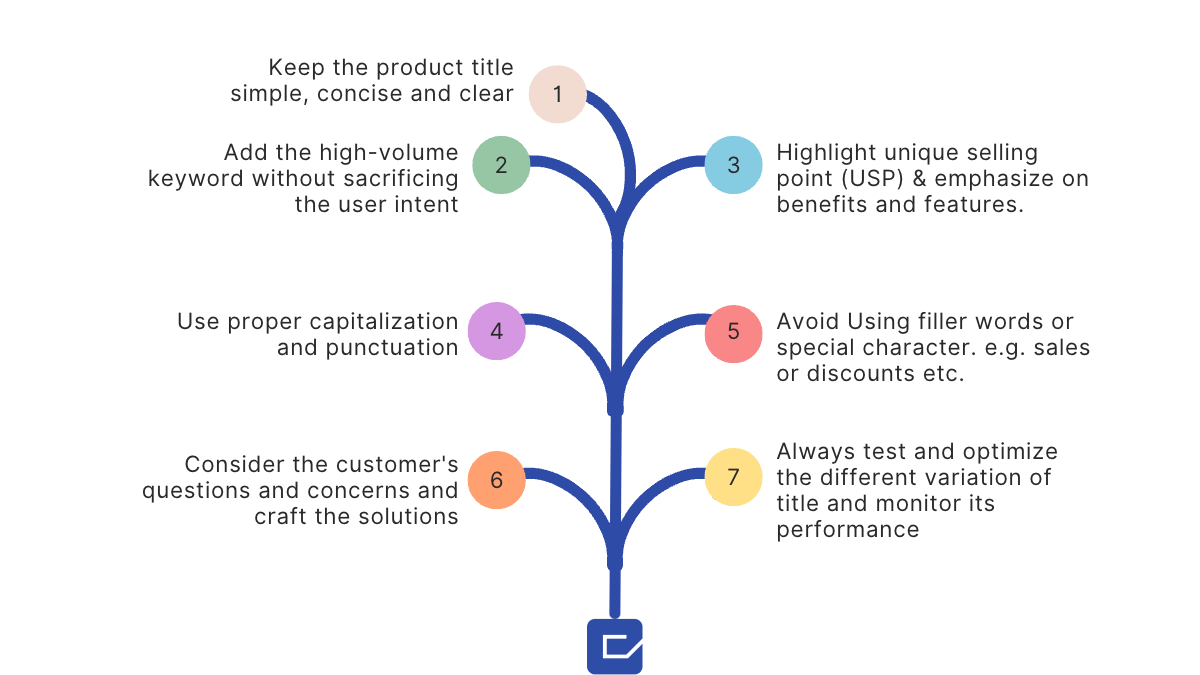Are you aware that 63% of shopping now takes place online, with Google and Amazon being the go-to destinations for shoppers? And with Amazon selling a staggering 66,000 orders per hour (that’s 18.5 orders per second), it’s crucial to optimize every aspect of your product listings to ensure better conversion rates. And speaking of optimization, did you know that crafting a winning Amazon product title is one of the most important factors to consider?
Don’t be left in the dust by your competitors!
We’ve got you covered with the top 7 tips for creating winning Amazon product titles that are sure to catch the eye of potential buyers. And to make it even more fun, we’ve included examples of some of the most clever and creative titles out there that will have your customers clicking “add to cart” in no time.
Why should you pay attention to product title optimization?
I won’t bore you with the importance of a good product title, because, let’s face it, you probably already know that. What I will stress, however, is that many sellers struggle to optimize their titles effectively. It’s easy to get bogged down in trying to fit everything in – keywords, features, benefits, brand name, and product names — and before you know it, you’ve exceeded Amazon’s maximum character limit.
But let me tell you, if your title is dull or crammed with meaningless jargon or wrong order, your potential customers will lose interest faster than a student in a boring lecture. So listen up, and let’s dive into the art of title optimization!
So, title optimization is the process of crafting a compelling and informative product title that effectively communicates the value and benefits of your product to potential customers. It involves using relevant keywords, character limits, and formatting to create a title that is not only eye-catching but also ranks well in Amazon’s search algorithm. Essentially, title optimization is all about making your product stand out in a sea of competitors and increasing your chances of making a sale.
What is the importance of optimizing the Amazon product title?
The value of a well-thought-out product title is not news to you. Truth be told, some things need to be brought up again, and others need to be emphasized.
Boost engagement and drive conversions
Even if your product is the best in the world, it won’t bring in sales if nobody sees it. This highlights the importance of crafting a catchy and informative title for your products on Amazon. If you make them interesting and useful, you can boost engagement and sales. Then again, who doesn’t appreciate a nice pun or play on words? In order to get people’s attention, you should come up with a pun-tastic title.
Align with the customer’s psyche
Did you know that the human mind is not rational? So, it is crucial to have your unique product resonate with your target market on an emotional level. The title of your product on Amazon is the first impression you’ll make on potential buyers, so it’s important to appeal to their emotions.
So, use the wording with keywords that make the reader feel happy, excited, or fulfilled. Keep in mind that your product is more than simply a thing; it’s also a feeling. Make sure that your product’s title conveys the satisfaction that customers will feel after purchasing your product.
In short, optimizing your Amazon product listings or titles is not just about adding keywords and information, it’s about creating a connection with your customers. To build that connection with your customers and with Amazon’s algorithm, it’s important that you should follow the tips below.
Amazon Product Title Requirement
For Amazon to accept a seller’s product titles, they have to meet a number of rules. Key needs are as follows:
Length
The Amazon title’s max characters are 200. That’s why a product’s title on Amazon can’t be more than 200 characters long (including spaces).
Related details
Titles must be true to the product being sold and include important details like the brand, type of product, and any key features or benefits.
Try to avoid irrelevant features
Promotional language or special characters are not appropriate for titles because they distract from the actual product being offered.
Get rid of the cliches
Repeating information already present in the product’s brand, manufacturer, or other qualities is prohibited.
Capitalization
- Use title case for titles, which implies that you should capitalize the initial letter of every word in the title (except for articles, conjunctions, and prepositions).
- Do not use the ampersand (&) in place of the word “and,” unless “and” is a trademarked component of the product’s name.
Beware of false claims
Any false or deceptive representations made about the product in the title must be deleted.
Avoid using these words
- Titles should not contain any offensive language, restricted product terms, or copyright or trademark violations.
- It’s preferable to keep things like prices, promotions, symbols, vendor info, and sly criticism out of the title.
- Using digits rather than words to represent numbers (e.g. 14 instead of fourteen).
- Measurement units should be written out in full rather than shortened (e.g. Pounds instead of lbs, etc.).
- If the color or size isn’t important to the product itself, there’s no need to specify it in the title
Overall, when writing Amazon product titles, it’s important to give accurate and relevant information about the product being sold while following Amazon’s rules to make sure you’re in compliance and get the most visibility and sales.
Best practices for writing amazon product titles with examples
Use the best tips below to make sure your product’s title is as effective as possible. You can also read about practices for optimizing your amazon listings here because crafting amazon listings is as important as product titles.
1-Keep it concise and clear
Amazon product titles seem to benefit from simplicity. Keeping your title simple and free of fluff will help it stand out. If you want your title to perform well, it needs to be clear and succinct. The title should make good use of the available space but avoid clogging it up with unnecessary details or adjectives. Instead, give your audience the gist of your offering in as few words as possible.
Example
Here are some examples of concise and clear titles:
- “Wireless Earbuds with Noise-Cancelling”
- “Men’s Leather Wallet with RFID Protection”
- “Reusable Stainless Steel Water Bottle”
In the same way:
Instead of “Amazing New Wireless Bluetooth Speaker with Ultra-Clear Sound and Sleek Design,” try “Wireless Bluetooth Speaker with Ultra-Clear Sound and Sleek Design.”
These titles are informative and concise, giving buyers all the information they need to make a purchase. You’ll not only make it simpler for customers to find your goods by keeping it succinct and obvious, but you’ll also raise the likelihood that they’ll click through to learn more.
2-Include the most relevant keywords
As an Amazon seller, you want to make sure that your products are easily discoverable by potential customers. However, it can be challenging to determine the right keywords to use in your product titles without sacrificing the intent behind them. The solution? Employ the power of keyword research tools like Helium 10, Jungle Scout, or AMZ Scout to identify the most relevant search terms.
By doing this, you can strategically place the most important keywords at the beginning of your title to improve your product’s visibility and help customers understand what it’s all about. But don’t just stuff your titles with a laundry list of keywords – that can come across as spammy and hurt your ranking.
Instead, strike a balance between high keyword volume and thoughtful user intent. By putting yourself in your customers’ shoes and anticipating their needs, you can tailor your product titles to meet their search queries effectively.
Example
If you’re selling a portable phone charger, use keywords such as “portable phone charger,” “fast charging,” and “compact” in your title, such as “Portable Phone Charger with Fast Charging and Compact Design.”
3-Highlight unique selling points
If you’re selling something on Amazon, you want it to stand out from the competition. One strategy for doing so is to prominently display your USP (Unique selling point) in the title of your product.
Find out what sets your product apart from the rest first. What makes your products so superior? Or maybe there’s something special about it that makes it stand out. Whatever it is, make sure to emphasize it in your title.
Create an emotional connection with potential customers by using powerful, descriptive, high-volume keywords. Use words like “sustainable” or “planet-friendly” to indicate that your product is environmentally friendly. Use phrases like “artisanal” or “crafted with care” to indicate that your product was hand-made.
Example
Here’s an example of how you could highlight your USP in an Amazon product title:
“Organic Bamboo Cutting Board – Handcrafted with Care for Sustainable Living”
By highlighting the fact that your product is both organic and handcrafted, you’re appealing to customers who are looking for eco-friendly and high-quality products. This not only helps your product stand out in the search results, but it also establishes your brand as one that cares about the environment and values craftsmanship.
In the same way,
If you’re selling a laptop case, highlight features such as water resistance, shock absorption, and durability, such as “Laptop Case with Water-Resistant and Shock-Absorbing Design for Ultimate Protection.”
4-Use proper capitalization and punctuation
Capitalization and punctuation are two small details that can make or break a product’s title on Amazon. To make the title more readable, capitalize the initial letter of each word and punctuate it correctly.
Example
Instead of “Super amazing wireless headphones with noise cancelling and microphone black”, try “Wireless Headphones with Noise Cancelling and Microphone – Black”.
5-Avoid using filler words or special characters
Avoid using useless filler words or characters in your Amazon product title optimization. Although these strategies may seem like a good idea at the time, they can give your title a spammy and unprofessional appearance, which will likely turn off your target audience.
Instead, focus on using clear and descriptive language to convey the most important information about your product. This will make it easier for customers to find and understand your product and improve your visibility and search ranking.
For example
Instead of using filler words like “sale,” “discount,” or “free shipping” in your title, try highlighting the most important features of your product. If you’re selling a smartwatch, you might use a title like “Fitness Tracker with Heart Rate Monitor and GPS” rather than “Best Deal Ever✨! Smartwatch with Heart Rate Monitor and GPS-Free Shipping!”.
6-Consider the user’s perspective
Think like a customer when crafting an effective Amazon product title. It’s important to consider the customer’s questions and concerns as you craft your solution. Use simple language and terminology that is common among your intended readers to make the title digestible.
Example
Instead of “Advanced Yoga Mat with Durable Non-Slip Surface”, try “Non-Slip Yoga Mat for Advanced Yogis—Durable and Comfortable”.
7-Test and optimize
After optimizing your Amazon product title, monitor its performance over time. Make adjustments and optimizations as needed to improve visibility and click-through rates. Test different variations of your title to see which one performs best.
Example
You can try testing different variations of your product title, such as “Portable Phone Charger with Fast Charging and Compact Design” versus “Fast-Charging Portable Phone Charger that is Compact and Lightweight”. Keep testing and optimizing until you find the best-performing title for your product.
Why should you trust an Amazon marketing agency to optimize your product title and listing?
You don’t have to tackle the arduous chore of optimizing your Amazon product title and listing alone. Using the services of a professional Amazon marketing agency to fine-tune your product’s title and listing is like calling in the military to save the day.
Consider this: would you employ a child to work on your car? What’s the point, then, of leaving your success on Amazon up to chance? When you hire a service with professional expertise, they can assist you in developing the ideal product name and listing to draw in the proper customers and boost sales.
Amazon Product Title Templates – Best Practices
We are going to provide you with some of the Amazon product title templates to give you a better understanding of how to use them. Here are some formulas that can be useful:
| Product Title Templates | Description | Examples |
| [Brand Name + Product Name + Key Feature/ Benefit] | This formula includes the brand name, the name of the product, and a key feature or benefit | “Nike Air Max 90 – Comfortable Running Shoes for Men.” |
| [Product Name + Model Number/Size + Key Feature/Benefit] | This formula includes the name of the product, the model number or size, and a key feature or benefit. | “Apple iPad Pro 12.9-inch – Powerful Tablet for Creative Professionals.” |
| [Product Category + Product Name + Key Feature/Benefit] | This formula includes the product category, the name of the product, and a key feature or benefit. | “Wireless Noise-Canceling Headphones – Sony WH-1000XM4 with Industry-Leading Noise Cancellation.” |
| [Product Name + Key Feature/Benefit + Target Audience] | This formula includes the name of the product, a key feature or benefit, and the target audience. | “Fitbit Charge 5 – Advanced Health Tracker for Fitness Enthusiasts.” |
| [Product Name + Unique Selling Proposition/Feature] | This formula includes the name of the product and a unique selling proposition or feature. | “Anker PowerCore 26800 – The Ultra-High Capacity Portable Charger.” |
These are the general templates to give you an idea. You can merge any of the templates to make your product title amazing. For example:
Product name + Model number + Brand name + Key features: [Product Name] [Model Number] by [Brand Name] with [Key Features]
Example: Apple MacBook Pro M1 by Apple with Retina Display and Touch Bar
Final Words!
In conclusion, optimizing the title of your Amazon product is a key step to getting more customers to see it and buy it. By following the tips outlined in this blog, you can create a title that is clear, concise, and keyword-rich, making it easier for customers to find and understand your product.
So go ahead and start optimizing your Amazon product titles today and see the difference they can make in your sales and visibility!
And don’t hesitate to contact our team of experts. Here at eComFist, we’ve got specialists who’ve been delivering amazon services for years. if you have any questions or need more help optimizing the titles of your products. We are here to help you succeed on Amazon!













